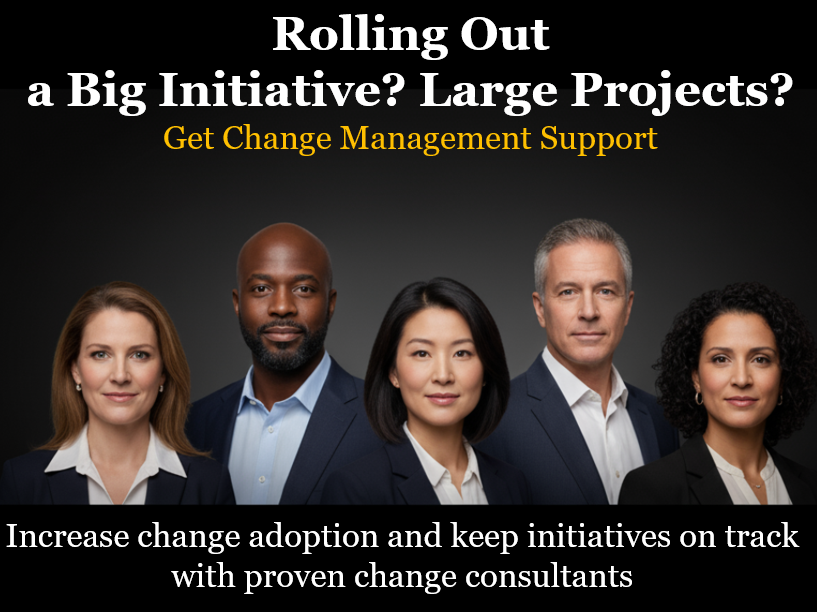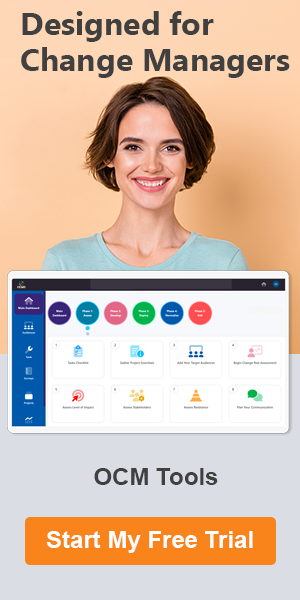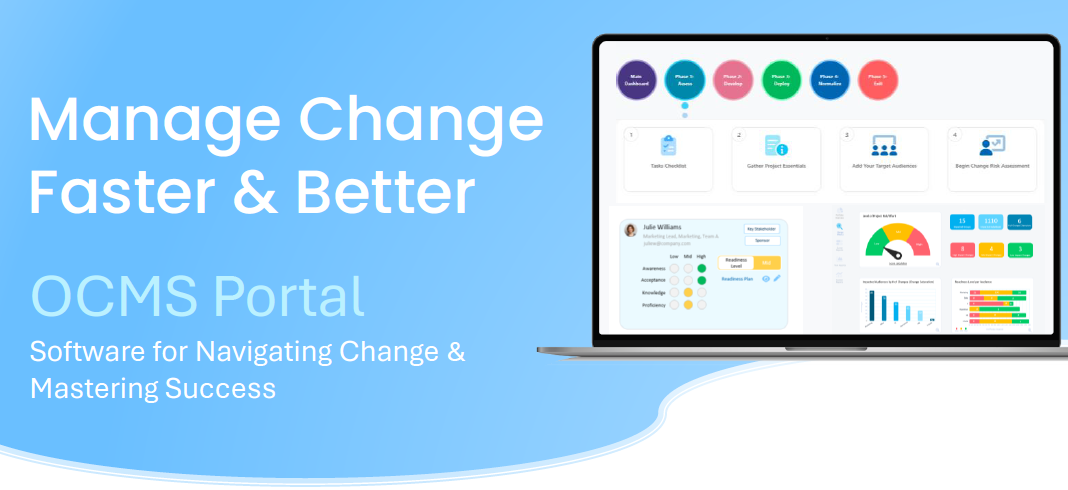How to Identify Different Forms of Organization Change for Your Project
Whether driven by new technology, process optimization, or internal restructuring, project changes can significantly impact employees, processes, and systems. For change management practitioners, the challenge lies not just in managing the change itself but in accurately defining and categorizing these changes to gauge their impact effectively.
There you are staring at your blank change impact analysis template. You’re stuck on how to identify the various changes from the project documentation. Identifying the changes is one of the first steps in business impact analysis. It’s a foundational practice in organizational change management (OCM).

When you clearly define the different types of organizational changes, you can use a change impact analysis tool to understand which groups and individuals are most affected. This insight allows you to prioritize resources and efforts, ensuring a smoother transition for all involved.
Below, we’ll explore the forms of organizational change, how to define them, and how these definitions feed into a BIA – business impact analysis for effective change management.
Story Highlights
|
Why Defining Changes Is Critical in Change Management Impact Analysis
Before diving into the specific types and forms of organizational change, let’s first address why defining these changes is critical. Not all changes are equal—some might affect the entire organization, while others may only impact specific teams or individuals. Understanding the scope and nature of each change helps you:
- Prioritize communication and training efforts.
- Identify the stakeholders most affected.
- Predict and mitigate resistance.
- Inform leadership and decision-makers of the risks and opportunities tied to the change.
This detailed understanding is crucial for inputting accurate data into your change impacts analysis tool, enabling you to predict how the change will unfold across the organization.
Are you leading or responsible for a mid-to-large project implementation? We can help. Learn more about how Airiodion Group can help you and your organization: Top Rated Change Management Consultants.
Learn more about how Airiodion Group can help you and your organization: Top Rated Change Management Consultants.
Please let us know if you would like to see more change impact assessment examples showing different types of organizational changes. We’ll be happy to provide more guidance.
Different Types of Organizational Change
To conduct an effective impact analysis in change management, you must first categorize the changes taking place in a project. Let’s break down the most common types of organizational changes:
1. Strategic Changes
Strategic changes involve shifts in the organization’s overall direction or vision. This might include entering new markets, changing product lines, or restructuring departments to align with new goals. These changes tend to have a broad impact and require high-level buy-in from leadership.
Example: A tech company decides to pivot from hardware to software solutions, requiring a complete overhaul of its product development, marketing, and sales strategies.
Strategic changes often affect multiple departments, making them a prime candidate for a detailed change impact assessment example. You’ll need to assess how this shift influences job roles, required skills, and employee engagement. This involves current and future state mapping, which we’ll discuss further down in this article.
2. Technological Changes
Technological changes involve implementing new tools, platforms, or systems that will impact how employees do their jobs. These changes often cause disruption as teams learn to use new technology while maintaining productivity.
Example: The introduction of an AI-powered project management tool that automates task allocation and performance tracking.
For this type of change, your change impact analysis for planning of change should focus on which roles will require reskilling, how workflows will change, and whether any job functions will become obsolete. Employees in roles most impacted by technology should be prioritized for training and support.
3. Structural Changes
Structural changes relate to changes in the hierarchy, reporting relationships, or team configurations. These can arise from mergers, acquisitions, or internal reorganizations.
Example: A company merges two departments to create cross-functional teams that handle end-to-end customer experiences.
Structural changes often create ambiguity around roles, responsibilities, and power dynamics. In your business impact analysis examples, pay close attention to how the new structure influences leadership and decision-making processes. The impact analysis in change management should also look at potential conflicts that could arise as teams adjust to new reporting lines.
4. Cultural Changes
Cultural changes can be the hardest to define and manage because they involve shifting the values, norms, and behaviors that make up an organization’s culture. These changes are often intangible but have a profound impact on how employees engage with each other and their work.
Example: A shift from a highly competitive, individualistic culture to one focused on collaboration and teamwork.
In your BIA – business impact analysis, consider how cultural changes will affect employee morale, communication styles, and levels of engagement. Often, these changes require significant leadership involvement and a clear communication strategy to avoid confusion or resistance.
5. Process Changes
Process changes focus on improving or altering workflows, methods, or procedures. This type of change can occur in any department and is usually aimed at increasing efficiency or reducing costs.
Example: A company implements a new agile methodology to improve product development cycles and adapt quickly to customer needs.
In your process impact analysis, consider the impact on day-to-day activities, which teams need training on the new process, and whether the change requires additional resources or technology.
Do you have questions about a change impact analysis example or the definition of change in organization? Please reach out and let us know.
Mapping Current and Future State Processes to Identify Changes
One of the most effective ways to understand and define organizational change being driven by a project is by mapping out your organization’s current state and future state processes. This process impact analysis comparison helps you clearly visualize where shifts will occur, who will be affected, and how workflows will need to adapt.
Mapping is particularly useful in the context of a stakeholder impact assessment because it offers a tangible way to identify the exact changes and their implications. This helps provide the definition of change in organization processes, roles, etc.
1. Understanding Current State Processes
Before diving into the future, you need a detailed map of your current workflows, structures, and procedures. The current state map outlines how tasks are completed, which teams are responsible, and what tools are being used. It’s essential to include input from various stakeholders to ensure you capture a complete and accurate picture.
Key elements to document in the current state process include:
- Roles and responsibilities: Who is involved in each step of the process?
- Tools and systems: What software, platforms, or tools are used to complete tasks?
- Timeframes: How long does each process step take?
- Challenges and bottlenecks: Are there any current inefficiencies or roadblocks?
2. Envisioning Future State Processes
Once you have a clear picture of the current processes, you can begin mapping the future state. The future state map represents how processes will function after the project is implemented. This includes any new roles, technologies, or workflows introduced as part of the planning of change, and the different types of organizational change.
When defining the future state:
- Identify improvements: What steps are being added, removed, or streamlined?
- Assign new roles: Are new teams or individuals responsible for parts of the process?
- Introduce new tools: Will new software or systems replace existing tools?
- Anticipate potential challenges: What new bottlenecks might arise, and how can they be addressed?
3. Identifying Changes Between Current and Future States
The most critical step in this process impact analysis is identifying the gaps between the current and future states. These gaps represent the forms of organizational changes that will need to be managed. Here’s how to spot these changes:
- Role changes: If certain roles are phased out or new ones are introduced, it could significantly impact certain teams or individuals.
- Technology shifts: Moving to a new platform or tool might require retraining, change management, or restructuring existing workflows.
- Process efficiencies: If a process is significantly streamlined, it may reduce the need for certain tasks, which could lead to changes in job roles or responsibilities.
4. Feeding into Change Impact Analysis
Once you’ve mapped out the differences between the current and future states, the next step is to input these changes into your business change impact assessment tool. By defining the specific areas where change will occur, you can better understand who will be impacted, the level of disruption, and the resources needed to support the transition.
Are you looking for more tips on how to define organizational change or doing a BIA business impact analysis? Sign up for our monthly OCMS newsletter!
Defining Organizational Change for Impact Analysis
Now that we’ve outlined the common types of organizational changes when planning for change management, it’s time to translate these changes into actionable data for your change impacts analysis.
Here’s a step-by-step change impact assessment process to define the changes in a way that will maximize the effectiveness of your change impact analysis example:
1. Assess the Scope of the Change
Start by determining whether the change is organization-wide, department-specific, or individual-focused. A business impact analysis example for an organization-wide change would include multiple departments, while a department-specific change would focus on fewer teams or stakeholders.
2. Identify Stakeholders
Once you’ve scoped the change, identify the groups and individuals who will be most affected. This includes both direct and indirect stakeholders. Direct stakeholders are those whose roles, responsibilities, or day-to-day activities will be altered, while indirect stakeholders might be affected downstream.
3. Determine the Nature and Categories of Organizational Change
Is the change strategic, technological, structural, cultural, or process-oriented? Defining the nature of the change will guide how to conduct a change impact assessment. For example, a cultural change will require a different communication plan and support structure compared to a technological change.
4. Evaluate the Impact
Once you’ve categorized the different types of organizational changes and identified impacted stakeholders, evaluate the impact on each group. This includes assessing how the change will affect roles, workloads, required skills, and employee morale.
For example, in business impact analysis examples for a technological change, you would need to evaluate whether employees are equipped to adopt the new technology or if reskilling is required.
5. Prioritize Based on Impact
When planning for change management engagement, not all changes will have the same level of impact. Use the data gathered to prioritize which definition of change in organization changes needs immediate attention. The goal is to ensure that high-impact changes, especially those affecting critical stakeholders, are addressed first.
Entering Changes into a Change Impacts Analysis Tool
Once you define organizational changes, the next step is to input this information into a change management impact analysis tool. These tools are essential for helping change management practitioners visualize and prioritize the impact of various changes. Here’s how you can make the most of your business change impact assessment:
Enter Detailed Information
Be as specific as possible when entering data into the tool. Include detailed descriptions of each change’s current and future states, the stakeholders involved, and the expected impact level. This ensures that the tool generates accurate analyses that you can act on.
Use Visualizations for Clarity
Many impact analysis tools offer visual aids like change saturation charts or impact matrices. These visualizations can help you quickly identify which changes are affecting the most stakeholders and where you should focus your resources in the planning of change management engagement.
Update Your Stakeholder Impact Assessment as Needed
Change is rarely static. As your project progresses, the nature of the changes may evolve, and new stakeholders may emerge. Be sure to update your change impact analysis tool regularly to reflect different types of organizational change that have emerged.
Please let us know if you have any questions about planning for change management, identifying changes for change impacts analysis, or populating a change management impact analysis.
Business Impact Analysis Examples in Change Management
Here are a few BIA – business impact analysis examples that illustrate how to categorize and manage different changes within a project:
- Technology Rollout: Implementing new software across multiple departments requires identifying affected teams, reskilling needs, and communication strategies to ensure smooth adoption.
- Department Restructure: Merging two departments may lead to role redundancies, requiring an impact analysis to evaluate layoffs, role changes, and the new reporting structure.
- Cultural Transformation: Shifting the company’s culture from a top-down approach to collaborative decision-making necessitates a detailed impact analysis focusing on leadership, team dynamics, and employee morale.
Conclusion: Planning for Change with Impacts in Mind
Successfully planning for change management in any project hinges on accurately defining and categorizing the changes you face. By understanding the different types of organizational changes—whether strategic, technological, structural, cultural, or process-oriented—you can better analyze and prioritize stakeholders and resources effectively.
Don’t let poorly defined changes derail your project. Use these insights and definition of change in organization examples to plan, execute, and manage change more effectively.
Top Change Impact Analysis & OCM Tools
What change management platform is trusted by Fortune 100 & 500 companies? OCMS Portal. Learn how to conduct a change impact assessment with ease, and get automated reporting that guides your change communications and priorities.
In addition to a streamlined change impact analysis tool, includes tools for stakeholder assessment, communications, training, and much more.
FAQ: Defining Types and Forms of Organizational Change
What is one of the first steps in business impact analysis?
One of the initial steps in business impact analysis is to identify the different categories of organizational change occurring. This could include structural changes, technology changes, process changes, culture changes, and others.
What is the most critical step when mapping current and future states?
The most critical step in the change impact assessment process of mapping is identifying the gaps between the current and future states. These gaps represent the different types and forms of organizational changes that will need to be managed.
Once project changes are identified, what should I do next?
The planning of change management for a project continues once you’ve identified the changes occurring. Next, you will identify the groups being impacted by each of the changes and the level of impact that change is having on the group. This information drives analytics that help you prioritize OCM engagement.
Do you need change management consulting support or help?
Contact Airiodion Group, a specialist change management consultancy that supports organizations, project managers, program leads, transformation leaders, CIOs, COOs, and more, who are navigating complex transformation initiatives. For general questions, contact the OCM Solution team. All content on ocmsolution.com is protected by copyright.
External Sources: stock.adobe.com





